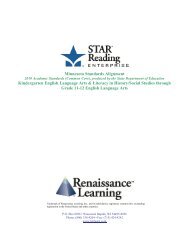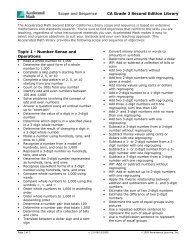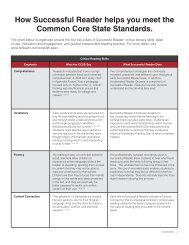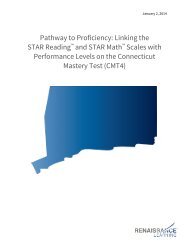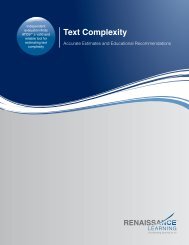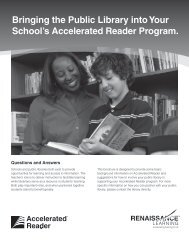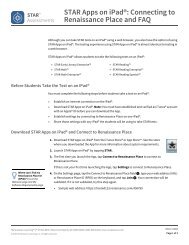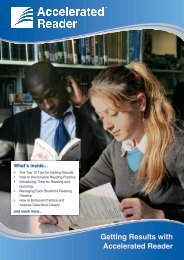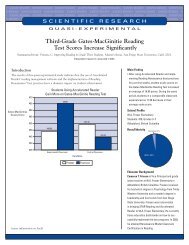Technical Manual - Renaissance Learning
Technical Manual - Renaissance Learning
Technical Manual - Renaissance Learning
You also want an ePaper? Increase the reach of your titles
YUMPU automatically turns print PDFs into web optimized ePapers that Google loves.
Reliability and Measurement PrecisionSTAR Early Literacy Enterprise Equivalence Study Datagrades and results are presented in Table 17. The table shows the grade, samplesize N and reliability coefficients for generic internal consistency reliability, retestreliability, and split half reliability.Table 17:Internal Consistency, Retest Reliability, and Split Half Reliability of STAREarly Literacy Enterprise (Assessments Taken in the 2012–2013 SchoolYear)Internal Consistency Reliability Retest Reliability Split Half ReliabilityGradeNReliabilityCoefficientNReliabilityCoefficientNReliabilityCoefficientPre-K 87,800 0.81 8,911 0.62 2,500 0.81K 2,376,036 0.80 190,790 0.61 2,500 0.781 2,057,861 0.81 110,617 0.54 2,500 0.792 555,834 0.84 29,217 0.72 2,500 0.853 129,383 0.90 9,161 0.79 2,500 0.90All 5,204,914 0.85 348,696 0.71 12,500 0.90Scaled Score SEMsThree different sources of data were available for estimating the aggregatestandard error of measurement of STAR Early Literacy Enterprise Scaled Scores:1. The averages and standard deviations of the conditional SEM (CSEM) valuescalculated by the STAR Early Literacy Enterprise software.2. Estimates of the global standard error of measurement computed from theestimated generic reliability and the observed standard deviations of theScaled Scores.3. Estimates of the standard error of measurement based on differencesbetween the initial test and retest Scaled Scores for those students who tookthe test twice.For the test-retest score data, the standard deviation of the test score differences,divided by the square root of 2 was used to estimate the standard error ofmeasurement. 55. Assuming that (1) measurement error variance is the same for both the initial test and the retest,and (2) the measurement errors are uncorrelated, the variance of the score differences is two timesthe measurement error variance of either test. The standard error of measurement is therefore thesquare root of the variance of the score differences divided by 2, which is identical to the standarddeviation of the difference divided by the square root of 2.STAR Early Literacy<strong>Technical</strong> <strong>Manual</strong>53





